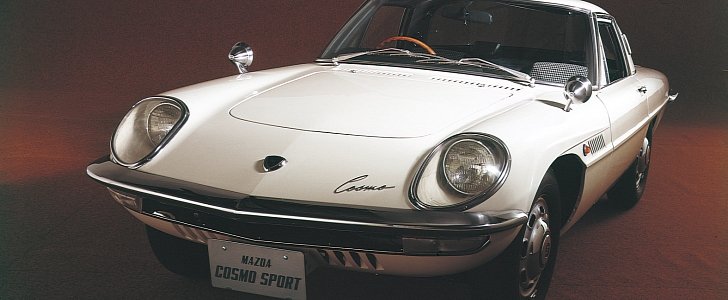Mazda is known for several things in the car industry, and one of them is its line of rotary engines.
While it was not the first automaker to use non-reciprocating motors, the Japanese company has defied all expectations with its creations, and the results were astounding and impressive from many points of view. Almost two million of these engines were made, and one of them won the 24 Hours of Le Mans in 1991.
Today, Mazda is celebrating five decades since it launched its first sports car, the Cosmo Sport. At the same time, the Cosmo Sport featured the first twin-rotor engine the world had ever seen.
It was sold as the 110S in the rest of the world, but the Japanese audience knew it as the Cosmo Sport. The model is a pillar in the foundation of the brand, as it is considered the inspiration for later cars like the RX-7, RX-8, and MX-5.
Mazda only built 1,176 units of the Cosmo Sport, but it mattered more than sheer volumes, because it changed the mindset of how the public viewed the brand. Instead of a light truck and small car manufacturer, Mazda became the convention-defying automaker, and it applied a design to match.
Unfortunately, Mazda does not offer rotary engines in its current portfolio, mostly because they were too expensive to adapt to the Euro 5 and Euro 6 emissions norms. The sales volumes of the rotary-powered cars were not exceptional to start with, and making them more expensive would be counter-intuitive.
However, the company is experimenting with various techniques and technologies that are supposed to help offer a new rotary-powered car in the future. It would have to comply with even more stringent emissions regulations, and the firm must figure out a way to stop the apex seals from failing.
The biggest problem of rotaries, however, is oil consumption, which leads to higher emissions, and nobody has a fix for it yet. Mazda has the best possible position to finding the solution, but it is unclear if it will happen soon. All we know is that we would love to drive a rotary-engined car once again.
Today, Mazda is celebrating five decades since it launched its first sports car, the Cosmo Sport. At the same time, the Cosmo Sport featured the first twin-rotor engine the world had ever seen.
It was sold as the 110S in the rest of the world, but the Japanese audience knew it as the Cosmo Sport. The model is a pillar in the foundation of the brand, as it is considered the inspiration for later cars like the RX-7, RX-8, and MX-5.
Mazda only built 1,176 units of the Cosmo Sport, but it mattered more than sheer volumes, because it changed the mindset of how the public viewed the brand. Instead of a light truck and small car manufacturer, Mazda became the convention-defying automaker, and it applied a design to match.
Unfortunately, Mazda does not offer rotary engines in its current portfolio, mostly because they were too expensive to adapt to the Euro 5 and Euro 6 emissions norms. The sales volumes of the rotary-powered cars were not exceptional to start with, and making them more expensive would be counter-intuitive.
However, the company is experimenting with various techniques and technologies that are supposed to help offer a new rotary-powered car in the future. It would have to comply with even more stringent emissions regulations, and the firm must figure out a way to stop the apex seals from failing.
The biggest problem of rotaries, however, is oil consumption, which leads to higher emissions, and nobody has a fix for it yet. Mazda has the best possible position to finding the solution, but it is unclear if it will happen soon. All we know is that we would love to drive a rotary-engined car once again.

